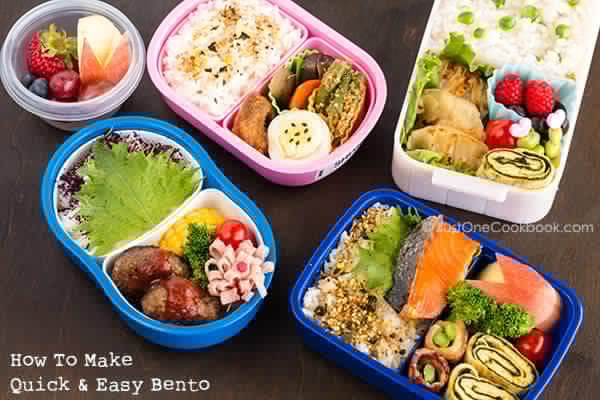
Many of Just One Cookbook readers have asked me to write a post about how to make bento since last year. I was hesitant at first because bento making is not something I specialized in, and there are so many great bento blogs out there that feature elaborate bentos that I wish to have for my lunch.
However, I continue to receive requests from readers so I’ve decided to share how I make everyday bentos (not a fancy one!) for my children.
I also included my very first video in this post!


I grew up eating mom’s homemade bento in school, and I even help packed my brother’s and my own bento in the morning with my mom when I was in high school (I was actually a morning person decades ago). My mom taught me the basic bento rule of thumb and I still follow the same guideline, which I will show you in this post.
For your information, I make bentos that can be all consumed in 10 minutes by my 5 year old daughter and 7 year old son.
This bento post is just to show you some ideas and tips that may be helpful for you to pack homemade lunches in bento box. Food does NOT have to be Japanese food. You can pack your own meals in bento box based on the guidelines below. Also, please adjust your bento box size and amount of food you put according to your needs.
Now let’s begin!
What You Need
- Bento Box (Lunch Box)
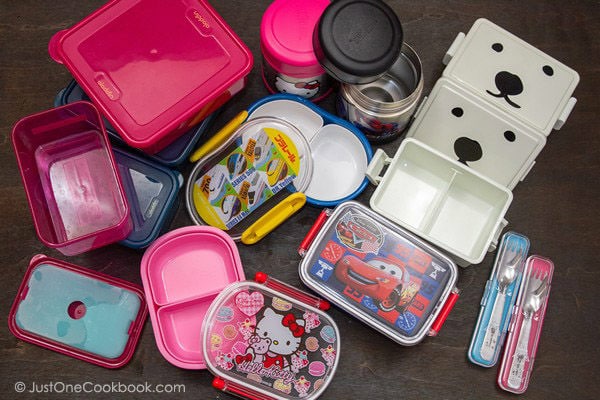
- Silicon Baking Cups and Dividers
Usually silicone cups and dividers come in bright and cheerful colors which improves the presentation for bento. They are reusable and come in many different sizes and colors. You can also use edible separators such lettuce, shiso leaves, cucumber slices, etc.
- Colorful picks and Sauce containers

Bento Rule of Thumb
Now that you have a bento box ready, let’s go over the basic rule of thumb on bento making!
Rule 1: Divide the Meal Proportionally
Dividing the meal proportionally will help you assemble a nutritiously balanced meal. It should at least have 4 types of food: carbs (carbohydrates), proteins, vegetables, and fruits. Be conscious about what types of foods to put in bento box when you are packing lunch.My children’s bento ratio is 4 : 2 : 1 : 1 (4 parts carbs : 2 parts protein : 1 part vegetables : 1 part fruits). I sometimes pack 2 parts of veggies inside the bento (skip fruit section) and prepare a separate container just for fruits.
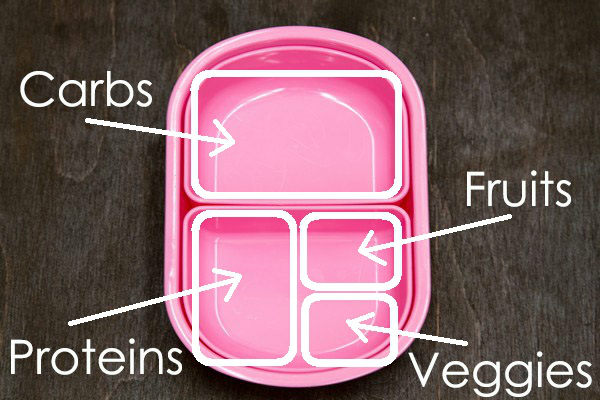
Rule 2: Keep in Mind to Add Colors
When making choices of which foods to include in the bento box, choose bold colors to provide visual impact. Not only do colorful vegetables and fruits add beautiful colors, but they are often the healthiest.
Red: tomato, carrot, red radish, bell pepper, apple, grapes, strawberries, plum, raspberries, nectarines, etc.
Yellow & Orange: corn, sweet potatoes, pumpkin, bell pepper, orange, lemon, banana, etc
Green: lettuce, cucumber, green onion, edamame, broccoli, spinach, okra, shiso, snap peas, asparagus, parsley, bok choy, green beans, Brussels sprouts, green peas, kiwi, etc
White: daikon radish, potato, onion, lotus root, enoki mushroom, white sesame seeds
Black & Brown: blueberries, shiitake mushroom, gobo (burdock root), wakame (dried seaweed), nori (dried seaweed sheet), hijiki (dried seaweed), black sesame seeds, etc.
If I have similarly colored dishes like broccoli and asparagus, I separate them and put other foods in between to make the bento more visually appealing. Sprinkling colorful furikake (rice seasonings) or garnishing with chopped parsley and green onion gives nice accents to overall presentation.
Rule 3: Pack the Foods Tightly
It’s important to pack the foods tightly to prevent the food from shifting in bento box. You don’t want to see messy bento when you (or your children) open the bento box at lunch time. Try packing in following order.- Pack pre-shaped or bulky food first.
- Then put more flexible-shape food in remaining spaces.
- Finally add some small accent food like cherry tomatoes and steamed broccoli to fill in the small gaps to prevent from shifting.
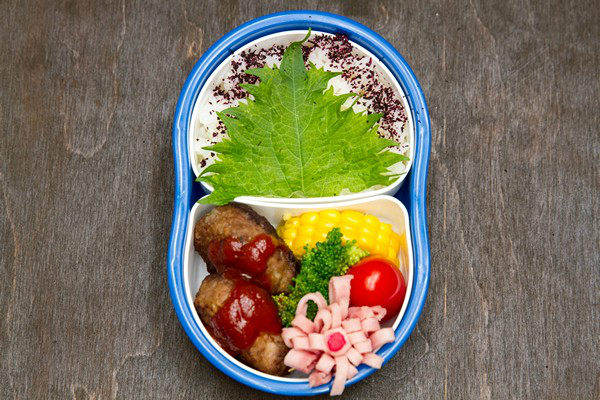
Now Let’s Pack Bento!
Step 1: Put Carbs
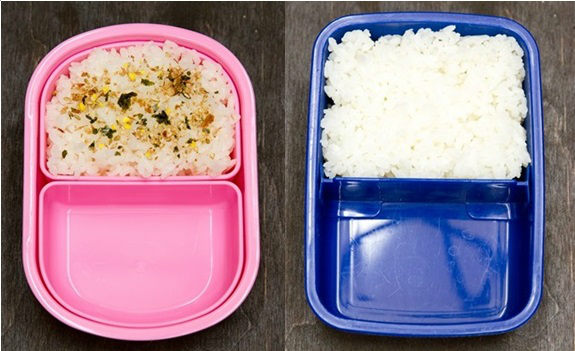
I usually fill 1/2 of bento box with carbs. Of course, you can pack brown rice, pasta, wraps, sandwich, bread, etc instead of white rice.
Step 2: Put Proteins
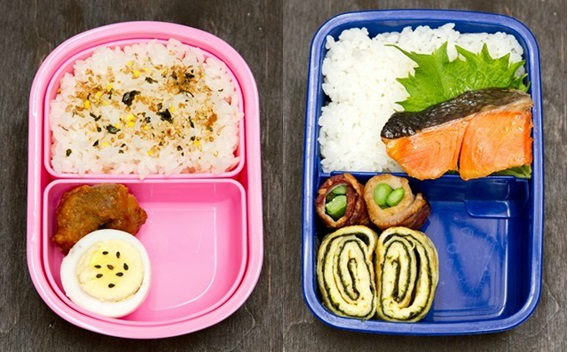 Any kind of beef, chicken, pork, tofu, beans, eggs, or other protein source can be packed in 1/4 of bento box. If possible, add 2 kinds of protein dishes in the spot.
Any kind of beef, chicken, pork, tofu, beans, eggs, or other protein source can be packed in 1/4 of bento box. If possible, add 2 kinds of protein dishes in the spot.Step 3: Put Vegetables & Fruits

Vegetables and fruits should be filled up in the remaining 1/4 of bento box. Packing at least 2 kinds of vegetable dishes is ideal. If you have more vegetable dishes, pack the fruits in a separate container.
5 Helpful Tips
Now how can you improve your bento making? Here are some helpful tips to make a tastier bento quickly!Tip 1: Use Pre-Cooked Meals to Save Time
If you want to pack bento quickly, use leftovers from previous dinner and a stash of frozen precooked meals. When I make bento-friendly menus, I always make a big batch of food, reserve a portion or two for that week, then freeze individual portions for later use. All I need to do in the morning is to re-heat pre-portioned food and pack into the bento. If you really want to make things easy, you can also pre-cut fresh veggies and fruits, cook a big batch of rice, and make many other dishes ahead of time.Tip 2: Keep Dry Foods Dry
To make sure not to spoil foods easily, separate wet foods from dry foods to keep them from getting soggy and unappetizing. Always drain sauce/dressing before packing into bento box. If you like to add some sauce, put on top of shredded cabbage/lettuce and put the food on top to avoid from spilling. You can also use a sauce container and pour it at meal time.Tip 3: Use Different Texture and Flavors
Eating different texture and flavor of foods will increase more appetite. If the main dish is seasoned with soy sauce base, avoid adding other similar flavor dish and try putting refreshing veggies instead.Also, keep in mind that food at room temperature tastes better when the food has more flavor. Use extra seasoning for bento portion or make the sauce more concentrated before taking away for bento portion.
Tip 4: Reheat & Cool Down Food Completely!
Food safety is especially important for bento. Always remember to wash your hands and use clean utensils when you touch food. I highly recommend you to re-heat the food before packing, and cool down the food completely before closing the bento. And don’t forget to keep ice packs in lunch bag! To read more about Food Safety Tips for Bento, click HERE.Tip 5: Plan Ahead
I know, for some people including myself, “planning ahead” can be hard. But once you get the hang of it, planning actually helps you save time and money, and you will always be more prepared despite your busy schedule.You just need to make 15-30 minutes of your time during the week and figure out what you have in the refrigerator, what you will be cooking throughout the week, and what you will need from grocery stores.
A friend of mine in Japan uses a meal planner to organize her dinner and bento menus. I adapted hers and made a simplified Bento Calendar. With this calendar, you can visually plan out your weekly dinners and bento menus. If you would like a copy, please Click HERE.
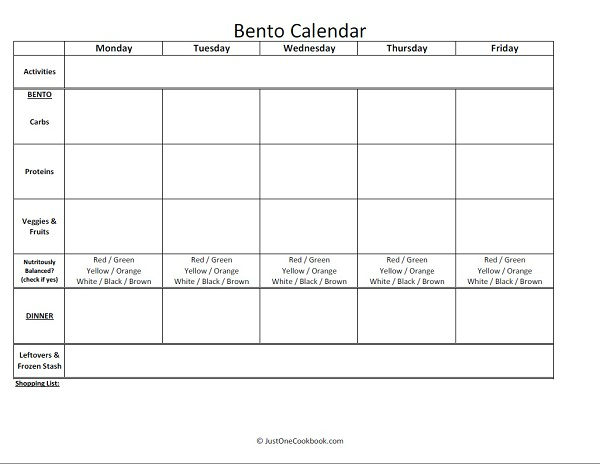
Comments
Post a Comment